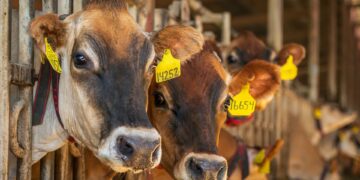Fertiliser prices have fallen from their 2022 peak, but South African farmers still face higher-than-average costs as the 2024/25 crop season nears. Thabile Nkunjana, a senior agricultural economist, notes that with demand sluggish and pressure on operating margins, the Rabobank affordability index signals further challenges ahead.
Global fertiliser prices have significantly decreased from the peak recorded in 2022, which is excellent news for net fertiliser producers like South Africa and many other countries that depend on fertiliser imports, but they have not yet reached the long-term average seen before 2020.
By the end of August 2024, global fertiliser demand has not increased as much as it did in 2023, despite early optimism for a rebound. This is because the market for essential fertilisers is still weak.

Due to pressure on farmers’ operating margins, the Rabobank fertiliser affordability index is currently neutral and is predicted to turn negative later in the year.
Fertiliser prices did not appear to be continuing the 2023 recovery at the same rate in the first half of 2024. A few days before October, when the Southern Hemisphere 2024/25 crop season – which includes South Africa and its bordering countries – begins, the situation with some fertilisers, such as Monoammonium Phosphate (MAP) and Diammonium phosphate (DAP), is still challenging.
Diammonium phosphate (DAP) increased 26.8% globally at the end of August 2024 year over year (y/y), whereas urea and ammonia increased by 20.3% and 13.4%, respectively.
Global fertiliser market impact amid price declines
Given that it is a net importer of inputs like fertilisers, pesticides, and crude oil, South Africa is not exempted from the global market fertiliser forces. In 2023, South Africa imported USD 824.4 million worth of fertiliser, a 45% decrease from USD 1.5 billion the previous year.
In 2023, Russia (20%), Saudi Arabia (15%), China (10%), Germany (10%), and Qatar (9%), were South Africa’s top fertiliser suppliers in value terms.
In 2022, South Africa was ranked among the top 20 fertiliser importers in the world and imports approximately 75% or slightly more of the fertiliser used annually, the majority of which is nitrogenous fertilisers.
Even though they were still higher at the end of August 2024, domestic fertiliser prices have drastically decreased from their peak in 2022 following the global trends. MAP peaked at R24 585 followed by potassium chloride (R23 660), Urea (R20 064), and LAN (14 956).
However, as of August 2024, potassium chloride had decreased 62% from its peak in 2022, while urea, LAN, and MAP had decreased 49%, 36%, and 30%, in that order.
On a year-on-year basis, a tonne of MAP was selling for R17 126 as of August 2024, up 30.6% from R13 117, while LAN was up 8.7% from R8 696 to R9 452. Potassium Chloride and Urea on the other hand were 20.6% and 10.0% down respectively.
Fertiliser pricing ripple effect
Many of South Africa’s neighbours are affected by the country’s fertiliser pricing since they import significant quantities of fertiliser from South Africa. For example, South Africa supplied 90% of Namibia’s fertiliser in 2021, 41% for Zimbabwe, and 35% for Zambia. Many others such as Botswana, Lesotho, and Eswatini import between 50% to 90% of their fertiliser from South Africa.
The expected rise in global fertiliser demand has not materialised. Given the existing dynamics of the fertiliser market and the declining prices of commodities, significant growth in 2024 appears doubtful. But even with the 2023 recovery, fertiliser prices are still far higher than in prior years.
Strong global crop yield projections are expected to keep pressure on commodity markets, which will drive down prices. As a result, following a relatively prosperous cycle between 2020 and 2023, farmers around the world are experiencing declining operating margins.
Given the demand, which primarily comes from neighbouring countries whose crops were severely damaged by drought this past summer, increased commodity prices for maize may be advantageous for South African farmers. This would somewhat cushion their profit margins in part.
The Rabobank fertiliser affordability index, which tracks both fertiliser and commodity prices, indicates that the positive cycle for fertiliser affordability will likely end within the next eight months.
This means that South African farmers will likely be getting ready for the winter crop the following season. It is unlikely that prices will trend back to the levels seen before 2020, given the current dynamics of the market, but only time will tell if prices recover.
- Thabile Nkunjana is a senior agricultural economist in the trade research unit of the National Agricultural Marketing Council. He writes in his personal capacity. The views and opinions expressed in this article are those of the author and do not necessarily reflect the views or positions of Food For Mzansi.
READ NEXT: How Voermol helped Mudau cut lamb mortality by 70%
Sign up for Mzansi Today: Your daily take on the news and happenings from the agriculture value chain.
















